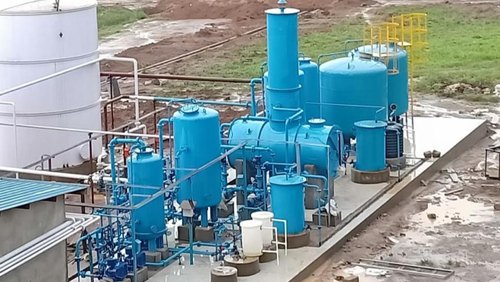PRODUCTS & SERVICES




Pretreatment - Primary Treatment
The feed water, depending on its source, may contain various concentrations and sizes of suspended solids and dissolved matter. The objective of the feed water pretreatment process is to improve the quality of the feed water to the level which would result in reliable operation of downstream equipment. Depending on the treatment requirements, pre-treatment systems are designed to get rid of troublesome impurities first. Fine suspended solids, colloids or silt can be removed by coagulation method where as some sparingly soluble salts such as fluoride, silica, iron etc can be removed by chemical precipitation method in pretreatment plants
KREYWIN provides following processes to make feed water suitable for the downstream processes:
A) Flocculators
Flocculators are used as preceding equipment to settling devices such as clarifiers or settlers. The main function of flocculator is to allow contact of flocculated particles with each other to form a larger floc which is easier to settle or trap than individual small particles. Flocculators can be used for making flocs of suspended solids as well as chemical precipitates. This equipment allows time for reaction and to allow particles to come in contact with each other with slow speed agitation. These can be constructed in metal as well as RCC and are equipped with flocculator shaft, blades and drives.
B) Clarifiers
1) Circular Mechanical Clarifier
These clarifiers settle the suspended matter from pre-flocculated water or effluent. The clarifiers are constructed in metal as well as RCC depending on the size and are equipped with scrapers, scraper drives, stationary or moving bridge, collecting launders, wear plates, v-notch boxes etc.
A variant in this equipment called clari-flocculator combines flocculation zone along with the conventional clarifier mechanism. This eliminates the need of having a separate equipment for flocculation. The settling is aided by virtue of gravity with carefully designed hydraulic flows and the sludge blanket formed with TSS also traps finer particles to provide clear water at the outlet.
2) High-Rate Solids Contact Clarifier
Commonly known as HRSCC, these are next generation technologies that achieve higher throughput in a smaller footprint than conventional clarifiers - resulting in cost savings and improved performance. The sludge formed in the settling process is re-introduced to feed water so that the process of floc formation is better. HRSCC suits best for varying or even low turbidity loads and optimizes the chemical costs.
The design features of the solids contact type clarifier provide the three zones necessary for proper clarification:
This ensures a higher clarified water quality and greater tolerance to variations in inlet conditions. KREYWIN is involved in producing hrscc, which is very reliable and cost-effective.
3) Inclined Surface Clarifier
Both these devices use the principle of high surface contact area and countering upward velocity with inclination of surface. The specific angle (60 0) results in lowering the upward velocity of particle thereby allowing higher rise rates and lower cross-sectional area. Plates and tubes used in these devices are available in various lengths, profiles and moc to suit specific applications.
KREYWIN is engaged in design, manufacturing and supply of inclined plate (lamella) clarifiers, tube settlers, which are based on innovative technologies that increase basin settling area by creating an inclined settling surface. Overall plant footprint can be reduced substantially using these technologies.
a) Tube Settler
KREYWIN offers compact clarification with advance gravity settling tube settlers in varied capacities. The tube settlers we provide occupy less space compared to conventional clarifiers. Tube settlers use multiple tubular channels that are inclined and adjacent to each other. When combined they effectively increase the effective settling area. The solids that collect on the tube settler slide down the tube channel to form a compact mass.
There no moving parts or mechanisms in a tube settler. Its compact design makes it ideal for small capacity and portable installations. The media is comprised of lightweight PVC tubes in a mild steel (MS) or concrete tank. Tube settlers provide for primary and secondary clarification post biological treatment.
b) Lamella Clarifier
The Lamella Clarifier consists of a series of closely spaced flat plates inclined at an angle. Preconditioned water with entrained solids enters the plate pack and flows between the plates.
The path length, plate spacing, and angle of the plate are the usual engineering variables. As the water flows between pairs of plates, the heavy solids with a specific gravity higher than the surrounding water will settle onto the top surface of the lower plate, and slide down the inclined surface to be collected in the sludge hopper. Clear, near solids-free water then exits the top of the plate area and flows over an adjustable weir.
Other Supplementary Equipment
A) Dosing System: Dosing systems are provided to dose chemicals, coagulants, flocculants required for reactions. The systems consist of dosing pumps of different types and moc, dosing tanks, agitator and mounting skids.B) Flash Mixers: Flash mixers are used for rapid mixing of chemicals before flocculation and are usually high-speed mixers with a small retention tanks.
C) Static Mixers: Sometimes, depending on the nature and criticality of process, inline static mixers can be used for mixing chemicals for rapid reaction. These are inline devices with internal baffle construction to increase turbulence for chemical mixing. Obviously, there is no running cost as there are no electrical or moving parts.
25, Ojo Olagun close, off Bishop Oluwole st,
Victoria Island Lagos Nigeria




